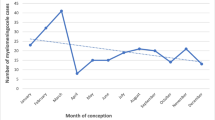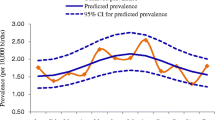Abstract
Purpose
To verify a seasonal variation in the incidence of spina bifida and thus to identify possible environmental triggers leading to its developement.
Methods
An interdisciplinary approach has been taken to develop a better understanding of spina bifida through collaborative efforts from investigators specializing in genetics, fetal pathology, paediatrics, neuro-surgery and prenatal ultrasonographic diagnosis. All pregnancies with fetal spina bifida were retrospectively analyzed from May 1 1993 through May 1 2010 at Luebeck University Fetal Health Center. Results were used to construct a model to predict the occurrence of fetal spina bifida based on seasonal variation and environmental influence reflected by climatic changes and environmental pollution. Furthermore, data were categorized in respect to the date of conception and subdivided into date of conception during summer (April–September) and winter months (October–March).
Results
Neither a seasonal distribution of conception for fetuses with spina bifida in the defined time frame could be verified nor a relevant influence of the analyzed environmental factors on the prevalence of spina bifida could be proved. The incidence of spina bifida has remained relatively stable within the last 17 years at 2.5 per 1,000 screened pregnancies.
Conclusion
Since we were unable to demonstrate a relationship between seasonal variation and certain environmental factors on the incidence of fetal spina bifida, other factors should be investigated for a possible association with the onset of fetal spina bifida.

Similar content being viewed by others
References
Canfield MA, Honein MA, Yuskiv N, Xing J, Mai CT, Collins JS (2006) National estimates and race/ethnic-specific variation of selected birth defects in the United States, 1999–2001. Birth Defects Res A Clin Mol Teratol 76:747–756
WHO 2010. http://www.who.int/entity/genomics/about/en/spinabifida.pdf
Rothenberg SP, da Costa MP, Sequeira JM, Cracco J, Roberts JL, Weedon J, Quadros EV (2004) Autoantibodies against folate receptors in women with a pregnancy complicated by a neural-tube defect. N Engl J Med 8(350):134–142
Shaw GM, Carmichael SL, Laurent C, Siega-Riz AM (2008) Periconceptional glycaemic load and intake of sugars and their association with neural tube defects in offspring. Paediatr Perinat Epidemiol 22:514–519
Shurtleff DB, Lemire RJ (1995) Epidemiology, etiologic factors, and prenatal diagnosis of open spinal dysraphism. Neurosurg Clin N Am 6:183–193
Simpson JL, Mills J, Rhoads GG, Cunningham GC, Conley MR, Hoffman HJ (1991) Genetic heterogeneity in neural tube defects. Ann Genet 34:279–286
DC C (2007) Folate status in women of childbearing age, by race/ethnicity–United States, 1999–2000, 2001–2002, and 2003–2004. MMWR 55:1377–1380
De Wals P, Tairou F, Van Allen MI, Uh SH, Lowry RB, Sibbald B, Evans JA, Van den Hof MC, Zimmer P, Crowley M, Fernandez B, Lee NS, Niyonsenga T (2007) Reduction in neural-tube defects after folic acid fortification in Canada. N Engl J Med 357:135–142
Frauenärzte im Netz, herausgegeben vom Bundesverband für Frauenärzte e.V. http://www.frauenaerzte-im-netz.de. Accessed 31 Oct 2010
Mattix KD, Winchester PD, Scherer LR (2007) Incidence of abdominal wall defects is related to surface water atrazine and nitrate levels. J Pediatr Surg 42:947–949
Bound JP, Harvey PW, Francis BJ (1989) Seasonal prevalence of major congenital malformations in the Fylde of Lancashire 1957–1981. J Epidemiol Community Health 43:330–342
EUROCAT 2010. http://www.eurocat-network.eu/
Dummer TJ, Dickinson HO, Parker L (2003) Adverse pregnancy outcomes near landfill sites in Cumbria, northwest England, 1950–1993. Arch Environ Health. Nov 58(11):692–698
Hindin R, Brugge D, Panikkar B (2005) Teratogenicity of depleted uranium aerosols: a review from an epidemiological perspective. Environ Health 4:17
Wells PG, McCallum GP, Lam KC, Henderson JT, Ondovcik SL (2010) Oxidative DNA damage and repair in teratogenesis and neurodevelopmental deficits. Birth Defects Res C Embryo Today 90:103–109
Auten RL, Potts EN, Mason SN, Fischer B, Huang Y, Foster WM (2009) Maternal exposure to particulate matter increases postnatal ozone-induced airway hyperreactivity in juvenile mice. Am J Respir Crit Care Med 15(180):1218–1226
Landesamt für soziale Dienste des Landes Schleswig Holstein 2010. http://www.schleswig-holstein.de
Deutscher Wetterdienst 2010. http://www.dwd.de
Williams LJ, Rasmussen SA, Flores A, Kirby RS, Edmonds LD (2005) Decline in the prevalence of spina bifida and anencephaly by race/ethnicity: 1995–2002. Pediatrics 116:580–586
Watkins ML, Rasmussen SA, Honein MA, Botto LD, Moore CA (2003) Maternal obesity and risk for birth defects. Pediatrics 111:1152–1158
Canfield MA, Ramadhani TA, Shaw GM, Carmichael SL, Waller DK, Mosley BS, Royle MH, Olney RS (2009) National Birth Defects Prevention Study. Anencephaly and spina bifida among Hispanics: maternal, sociodemographic, and acculturation factors in the National Birth Defects Prevention Study. Birth Defects Res A Clin Mol Teratol 85:637–646
Czeizel AE, Dudás I (1992) Prevention of the first occurrence of neural-tube defects by periconceptional vitamin supplementation. N Engl J Med 24(327):1832–1835
Dummer TJ, Dickinson HO, Parker L (2003) Adverse pregnancy outcomes near landfill sites in Cumbria, northwest England, 1950–1993. Arch Environ Health. Nov 58(11):692–698
Domingo JL (2001) Reproductive and developmental toxicity of natural and depleted uranium: a review. Reprod Toxicol 15:603–609
Auten RL, Potts EN, Mason SN, Fischer B, Huang Y, Foster WM (2009) Maternal exposure to particulate matter increases postnatal ozone-induced airway hyperreactivity in juvenile mice. Am J Respir Crit Care Med 15(180):1218–1226
Strickland MJ, Klein M, Correa A, Reller MD, Mahle WT, Riehle-Colarusso TJ, Botto LD, Flanders WD, Mulholland JA, Siffel C, Marcus M, Tolbert PE (2009) Ambient air pollution and cardiovascular malformations in Atlanta, Georgia, 1986–2003. Am J Epidemiol 169:1004–1014
Wells PG, McCallum GP, Lam KC, Henderson JT, Ondovcik SL (2010) Oxidative DNA damage and repair in teratogenesis and neurodevelopmental deficits. Birth Defects Res C Embryo Today 90:103–109
Karttunen V, Myllynen P, Prochazka G, Pelkonen O, Segerbäck D, Vähäkangas K (2010) Placental transfer and DNA binding of benzo(a)pyrene in human placental perfusion. Toxicol Lett 197:75–81
Ramos KS, Nanez A (2009) Genetic regulatory networks of nephrogenesis: deregulation of WT1 splicing by benzo(a)pyrene. Birth Defects Res C Embryo Today 87:192–197
Acknowledgments
The authors named above declare that there is no source of financial support of the study, including provisions or services from third parties.
Conflict of interest
The authors named above declare that there is no conflict of interest of a financial or other nature.
Author information
Authors and Affiliations
Corresponding author
Additional information
The study is registered under clinicaltrials.gov. NCT: 01100697.
Rights and permissions
About this article
Cite this article
Beyer, D.A., Diedrich, K., Weichert, J. et al. Seasonality of spina bifida in Northern Germany. Arch Gynecol Obstet 284, 849–854 (2011). https://doi.org/10.1007/s00404-010-1762-0
Received:
Accepted:
Published:
Issue Date:
DOI: https://doi.org/10.1007/s00404-010-1762-0




